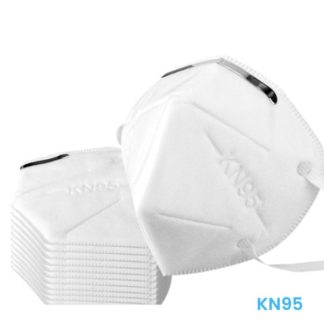
“Air pollution is only outside, once I’m indoors I’ll be fine.”
…Heard that one before?
Indoor air quality may seem like an abstract concept, or perhaps it doesn’t seem like a threat. But it is. It’s a big threat. Most people don’t realize how detrimental to their quality of life the air they breathe every day truly is.
Generally speaking, we don’t see what’s in the air we breathe, and we feel safer inside. Often, we might even see things in the air, but we ignore them, because we continue to breathe. We assume that since we’re used to it, it’s harmless.
But we’re not really “used to it,” are we? That’s a trick our brain plays on us.
In reality, there are numerous physical side effects from breathing in these contaminants. People spend most of their time inside, so of course the inside air matters (NIH).
Health effects from indoor air pollutants can affect you soon after exposure, or in some cases, years later (EPA), so it’s important to avoid them. But how can you spot these hazards?
Do you recognize any of these dangers and their symptoms in your workplace?
Keep an eye out for symptoms in your workplace. Often, symptoms will inform you of the issue at hand.
Pollen
Studies have shown that pollen seasons are getting longer, not shorter (PNAS). Pollen allergies bring:
- Sneezing
- Sniffling
- Coughing
- watery and itchy eyes
- Headaches
- Sore throats
…or worse. And with increased pollen in the air for a longer period each year, these symptoms are not likely to lessen. This can affect productivity, attendance, and morale in a workspace.

Smoke
Smoke from wildfires or industrial fires can travel far and wide. The bigger the fire, the farther the smoke goes — as we’ve seen in recent years, that can be hundreds or even thousands of miles away.
And in addition to turning the sky orange, that smoke pollutes the air in several big ways. Smoke pollution can contain fungi, bacteria, heavy metals (like lead), and even, yes, airborne pathogens (LA Times).
When smoke envelops a region, you are likely to experience:
- Burning eyes
- Runny nose
- Coughing or wheezing
- Phlegm buildup
- Difficulty breathing
- Chest pain or palpitations, especially for those with heart disease
These symptoms are likely to linger long after the smoke clears and the sky turns back to blue. What’s more, exposure to smoke was found to increase susceptibility to COVID-19 (Journal of Exposure Science & Environmental Epidemiology).

Mold
Mold spores are sneaky, in that they can enter an indoor space by floating through open passageways (windows, doors, vents, etc.), or they can attach to clothing, shoes, backpacks, or things that can be carried in and out with foot traffic. Mold brings a variety of problems and is sometimes hard to detect. Be aware of these signs in your workplace:
- Allergic reactions with pulmonary effects
- Development of asthma, or worsening of asthma symptoms
- Fever
- Shortness of breath
Mold exposure especially increases risk of development of asthma in young children who are genetically susceptible (CDC).

Chemical fumes/VOCs
Volatile organic compounds (VOCs) are chemicals that vaporize into the air, which can linger for long periods of time and cause a variety of unpleasant experiences. The range of experiences includes:
- Unpleasant odors
- Eye, nose, and throat irritation
- Breathing difficulty
- Nausea
- Central nervous system damage
Long term exposure to certain VOCs can even cause cancer (American Lung Association).

Biological hazards
Perhaps the most immediately serious risks you can breathe in are biological hazards — airborne pathogens like bacteria and viruses that can cause disease to their host. They spread most commonly through small respiratory droplets, and on the aerosols that we breathe out literally every time we exhale. Coughing, sneezing, laughing, singing — these can all increase the concentration of pathogens in the air inside a room. Common diseases spread through droplets and aerosols include:
- The common cold
- Influenza (the flu)
- Measles
- Chickenpox
- COVID-19
…And many more. These contagions can linger in the air for minutes or even hours, long after the original host has left the room.
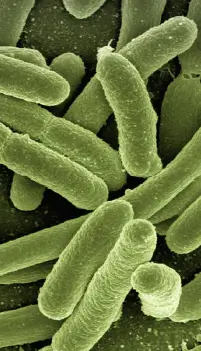
Ways to address the dangers of poor indoor air quality
There are many ways to improve indoor air quality and advance safety in your work setting. As we have mentioned before, there are varying levels at which to address these dangers.
Remove & replace the bad air with good
At the broadest scale, diluting the prevalence of particulates decreases your odds of breathing in harmful toxins. You can do this by replacing as much indoor air with outdoor air as you can, provided the outdoor air is suitable. Heavy pollution nearby, extreme temperatures, and inclement weather can negate these efforts, so common sense should be employed.
One commonly recommended action that’s easy to do is opening windows & using screen doors. This can help outdoor air mix into the indoors. Time and architecture will affect the rate at which air is exchanged, though, so you may have to help that air move. Floor or window fans can assist this effort.

Building ventilation
Most buildings have some degree of ventilation available, and filters can be employed. This not only helps replace inside air with outside air, it also cleans the inside air. In fact, ventilation is of primary concern for maintaining healthy indoor air quality and reducing the spread of airborne infectious disease (ChemRxiv).
The American Society of Heating, Refrigerating and Air-Conditioning Engineers (ASHRAE) recommends filtration using the MERV scale. Ideally, they recommend implementing MERV-13 filtration if your building’s ventilation system can handle it. The higher the MERV rating, the better the filtration — however, more filtration does put more strain on a system’s ability to move air, so if your system cannot accommodate MERV-13, you should use the highest MERV rated filters you can.
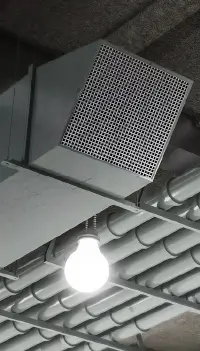
Clean the air in the room
A typical building’s ventilation system produces 2 to 3 air changes per hour (ACH). But the CDC recommends keeping safe from the spread of disease with 5 or more ACH.
To supplement your building’s ventilation, they recommend bringing in portable HEPA air purifiers. ACH is additive, and air purifiers in a room will increase the ACH. For multiple rooms, use multiple units.
Vaniman’s Pure Breeze HEPA Air Purifier produces an additional 2-3 ACH for a typical 1,000-sq. ft. room, helping achieve the recommended 5 ACH.
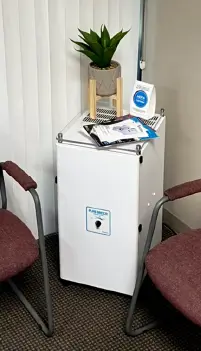
Prevention
As with many problems in life, it is easier and smart to prevent than to react to indoor air contamination. Consistent air exchanges, ventilation, and ongoing air scrubbing are long-term solutions with long-term benefits. The air is safest when all these approaches are used together, as opposed to just one.
Benefits & co-benefits of improved indoor air quality (IAQ)
The threats of contaminated indoor air are something most of us live with every day. Taking measures to improve your IAQ can bring a variety of noticeable benefits, both direct and indirect.
Better health
Improving IAQ improves physical health for everyone in a workspace. The more contaminants you remove from everyday air, the more you see decreases in:
- Respiratory symptoms
- Asthma symptoms
- Headaches/migraines
Decreases in absenteeism due to illness
Naturally, when physical health is improved, workplaces enjoy better attendance. The same applies to schools and universities — staff as well as students (The Lancet Commission).
Cognitive function and productivity
Improved IAQ has also been shown to improve cognitive function, and for students in academic settings, improved test scores. Additionally, productivity is higher in environments with better IAQ. This benefits businesses as well as customers.
Staff morale
Research shows that ventilation and air cleaning improvements lead to, among other things, improved morale (The Lancet Commission). This brings another co-benefit: staff retention.
All these things together can create an environment far more stable and successful than average, and actions and resources to address IAQ are accessible and affordable. There’s no reason to delay improving the air quality in your workplace!
Some simple steps you can take right away
- Install screen doors and screen windows if it makes sense in your region to do so
- Check the building’s ventilation system for fresh filters, and upgrade your filtration if your system can handle a higher MERV rating
- Place commercial-grade portable HEPA air purifiers throughout the space
- Encourage the use of masks to avoid contracting and spreading airborne diseases
To learn more about Vaniman’s portable HEPA air purifiers, or to order units and accessories online, click here. Our Pure Breeze HEPA Air Purifier is on the list of CARB-Certified air cleaning devices.
If you have questions about air purifiers, please reach out to Vaniman today!
Shop HEPA air purifiers
-
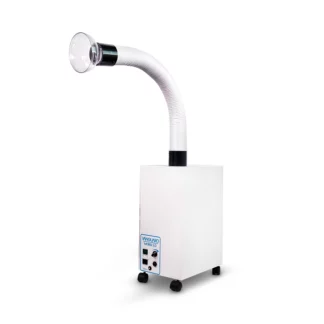 Vanguard Mobile 2.0 – Extraoral Dental Suction for Aerosols – 10337$1,300.00View Details
Vanguard Mobile 2.0 – Extraoral Dental Suction for Aerosols – 10337$1,300.00View Details -
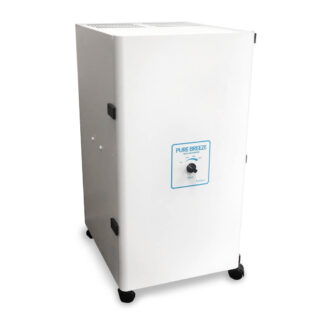 Pure Breeze HEPA Air Purifier – 10360A$1,926.86 – $2,055.86View Details
Pure Breeze HEPA Air Purifier – 10360A$1,926.86 – $2,055.86View Details -
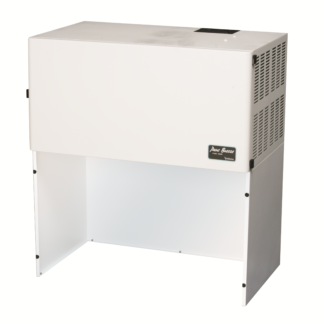 Pure Breeze Bench Top HEPA Fume Hood – 10372$2,092.16View Details
Pure Breeze Bench Top HEPA Fume Hood – 10372$2,092.16View Details -
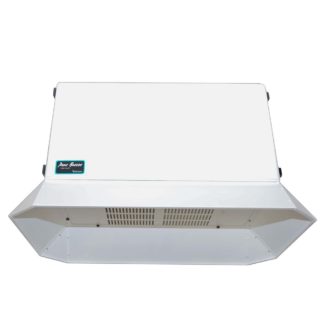 Pure Breeze HEPA Fume Hood – 10370$1,926.86View Details
Pure Breeze HEPA Fume Hood – 10370$1,926.86View Details
Shop KN95 masks
SOURCES:
NIH-National Institute of Environmental Health Sciences, Indoor Air Quality: https://www.niehs.nih.gov/health/topics/agents/indoor-air/index.cfm
EPA, Introduction to Indoor Air Quality: https://www.epa.gov/indoor-air-quality-iaq/introduction-indoor-air-quality
PNAS, Anthropogenic climate change is worsening North American pollen seasons: https://www.pnas.org/doi/10.1073/pnas.2013284118
LA Times, With metals and maybe even coronavirus, wildfire smoke is more dangerous than you think: https://www.latimes.com/california/story/2021-07-22/studies-connect-wildfire-smoke-side-effects-covid-19-risk
Journal of Exposure Science & Environmental Epidemiology, SARS-CoV-2 test positivity rate in Reno, Nevada: association with PM2.5 during the 2020 wildfire smoke events in the western United States: https://www.nature.com/articles/s41370-021-00366-w
CDC, Ventilation in Buildings: https://www.cdc.gov/coronavirus/2019-ncov/community/ventilation.html
CDC, Basic Facts About Mold and Dampness: https://www.cdc.gov/mold/faqs.htm
American Lung Association, Volatile Organic Compounds: https://www.lung.org/clean-air/at-home/indoor-air-pollutants/volatile-organic-compounds
ChemRxiv, Room-Level Ventilation in Schools and Universities: https://chemrxiv.org/engage/chemrxiv/article-details/61129d9ee540bb3ea1753d38
ASHRAE, Filtration and Disinfection FAQ: https://www.ashrae.org/technical-resources/filtration-and-disinfection-faq
Mayo Clinic, How well do face masks protect against COVID-19? https://www.mayoclinic.org/diseases-conditions/coronavirus/in-depth/coronavirus-mask/art-20485449
The Lancet COVID-19 Commission Task Force on Safe Work, Safe School, and Safe Travel, Designing infectious disease resilience into school buildings through improvements to ventilation and air cleaning: https://www.vaniman.com/wp-content/uploads/bsk-pdf-manager/2021/06/LancetCommissionSafeWorkTFDesigininginfectiousdiseaseresilienceApril2021.pdf
Institute for Educational Leadership, Working in Urban Schools: https://files.eric.ed.gov/fulltext/ED299356.pdf
California Air Resources Board, List of CARB-Certified Air Cleaning Devices: https://ww2.arb.ca.gov/list-carb-certified-air-cleaning-devices

